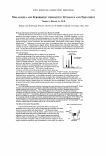100 JOURNAL OF COSMETIC SCIENCE was consistently more effective than skin rapes at day 7 (Figure 1), and these differences were statistically significant with p values of 0.05 for the overall acne severity grade, 0.05 for redness, 0.01 for oiliness, and 0.02 for dark pigmentation. After treatment with Acne Dressing®, the results showed there was significant improve- ment over the pre-treatment state of acne conditions (including redness, oiliness, and pigmentation) (p $ 0.05) (Table III). Improvement in acne conditions as assessed by the patients was significantly reduced in the treatment group compared with the skin rapes group, as demonstrated by the mean ± SD change: 2.1 ± 0.57 and 4.2 ± 0.79, respec- tively (p $ 0.05) (Figure 2). All treatment-group patients considered that there was moderate improvement or better. However, only 20% of the skin tapes patients con- sidered there was a moderate improvement in treatment. SEBUM CASUAL LEVEL EVALUATIONS There were significant differences between the two groups in the sebum casual level at day 7, as demonstrated by the mean ± SD change from baseline: 186.9 ± 53.04 and 241.8 ± 62.93 (p $ 0.05) (Figure 3). However, there were no significant differences at baseline, on day 3 and, on day 5 in the sebum casual level. Comparing the before and after treatment with Acne Dressing®, the results showed there was significant improve- ment in acne conditions (including redness, oiliness, and pigmentation) (p $ 0.05) (Table III). However, there were no significant differences between the pre- and post- treatment states in the skin rapes group. ULTRAVIOLET PENETRATION TEST As shown in Figure 4, it is clear that the ratio of transmission in Acne Dressing® during the period of UVB exposure (280 nm-320 nm) is less than 7 .4%, indicating that Acne Dressing® is a useful material to block UVB from sunlight from reaching the skin 1.4 g 1.2 � 1 � 0 0.8 ·E o.6 � 0.4 � 0.2 0 Baseline ■ group 1 □ group2 day3 day5 day? day Figure 1. Improvement in the mean overall acne severity grade after treatment with Acne Dressing® (group 1) or skin tapes (group 2).
EFFICACY TREATMENT OF ACNE VULGARIS 101 Table III Acne Dressing® or Skin Tapes Used to Examine the Effect on Acne Conditions (n = 20) Acne Dressing® Skin tapes Baseline Day 7 Baseline Day 7 Significance Severity of acne by patients 1 1.18 0.43 1.08 0.80 .000* Severity of acne by physician 1 0.90 0.16 0.65 0.41 .000* Scale of redness 2 4.1 1.2 4.4 2.7 .000* Scale of oiliness 2 3.9 1.5 4.0 2.4 .000* Scale of dark pigmentation2 3.9 1.8 3.7 2.3 .000* Sebum casual level (µg/cm2) 217.6 186.9 240.8 241.8 .000* * p 0.05. 1 Severity of acne was assessed and performed by using Dr. Cunliffe's grading system. 2 Scales of redness, oiliness, and dark pigmentation were assessed by five-point Likert scale. surface covered by the dressing. However, the ratio of transmission in skin tapes during the period of UVB exposure (280 mm-320 mm) is 38%. DISCUSSION Acne vulgaris is a common skin disorder that poses significant social and psychological problems to the patient (10). It is most prevalent during adolescence, which is a· time of significant physical, emotional, and interpersonal relational development (11). Negative self-perceptions of one's face can have a lifelong consequence. Therefore, the develop- ment of a safer, more convenient, and more effective treatment for acne is highly desirable. Results from clinical assessments show that Acne Dressing® compared with skin tapes was more effective in improving local mild and moderately inflamed acne. Most patients have reported improvement (a reduction in size and redness and less oily skin) after seven days of treatment with Acne Dressing®. The mean percentage decrease in severity of acne after seven days of Acne Dressing® treatment was 82.2% compared with 37% for skin tapes. Ninety percent of patients in the treatment group indicated that the Acne Dressing® absorbed the secretions from the acne, and then reduced the inflammation and pain. Moreover, 95% of patients indicated that the color of this kind of Acne Dressing® was similar to that of skin and that the circular formulary form was very easy to use and enhanced cosmetic appearance. Many studies of acne emphasize that treatment of acne is needed to reduce inflammation and avoid scarring (1,3,12,13). Measures of efficacy in the study show that the mean percentage decrease in redness after seven days of Acne Dressing® treatment was 71 % , as compared with 38.6% for skin tapes. It is also clear that comparison of the pre- and post-Acne Dressing® states shows a significant reduction in redness. All patients treated by Acne Dressing® felt their inflamed acne was much better, and there was a decrease in the number of days of healing (mean = 3.20 ± 0.79) over the skin tapes group (mean = 4.30 ± 0.79). From this viewpoint, Acne Dressing® therapy was more effective in alleviating the acne. All patients treated by Acne Dressing® reported moderate or good improvement. Moreover, there were no adverse effects or patient discomfort noted in any of the patients.
Purchased for the exclusive use of nofirst nolast (unknown) From: SCC Media Library & Resource Center (library.scconline.org)










































































































